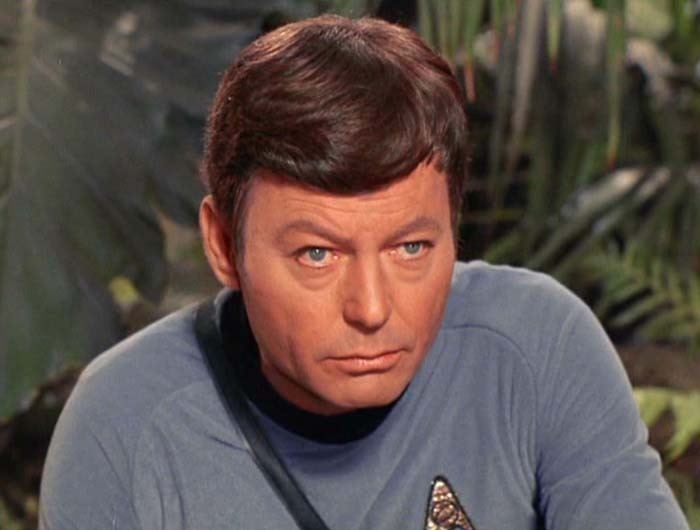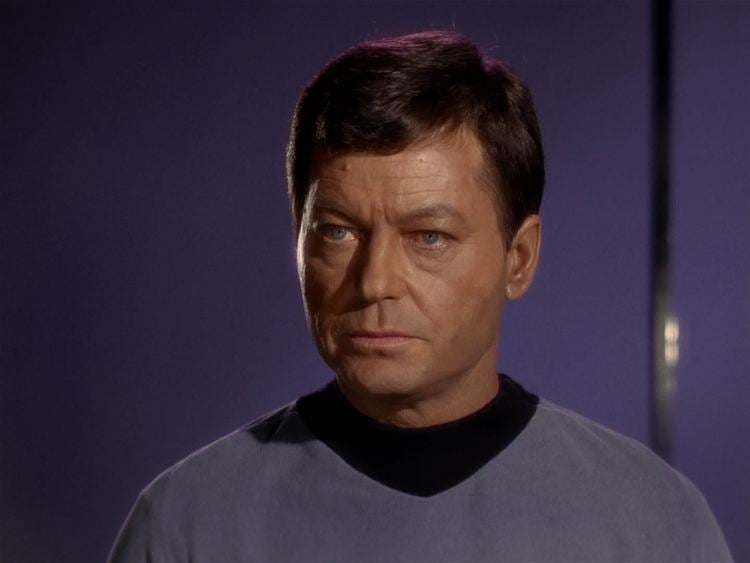Species Human Occupations Chief medical officer | Rank Admiral | |
 | ||
Similar | ||
Dr. Leonard H. "Bones" McCoy is a character in the American science fiction franchise Star Trek. First portrayed by DeForest Kelley in the original Star Trek series, McCoy also appears in the animated Star Trek series, six Star Trek films, the pilot episode of Star Trek: The Next Generation, and in numerous books, comics, and video games. Karl Urban assumed the role of the character in the 2009 film Star Trek, and its sequels, 2013's Star Trek Into Darkness and 2016's Star Trek Beyond.
Contents
Depiction

McCoy was born in Atlanta, Georgia, January 20, 2227. The son of David, he attended the University of Mississippi and is a divorcé, but later married Natira, the priestess of Yonada, characterized in the episode, "For the World Is Hollow and I Have Touched the Sky". In 2266, McCoy was posted as chief medical officer of the USS Enterprise under Captain James T. Kirk, who often calls him "Bones". McCoy and Kirk are good friends, even "brotherly". The passionate, sometimes cantankerous McCoy frequently argues with Kirk's other confidant, science officer Spock, and occasionally is bigoted toward Spock's Vulcan heritage. McCoy often plays the role of Kirk's conscience, offering a counterpoint to Spock's logic. McCoy is suspicious of technology, especially the transporter. As a physician, he prefers less intrusive treatment and believes in the body's innate recuperative powers. The character's nickname, "Bones", is a play on sawbones, an epithet for physicians qualified as surgeons.
Kirk orders McCoy's commission reactivated in Star Trek: The Motion Picture (1979); a resentful McCoy complains of being "drafted". Spock transfers his katra—his knowledge and experience—into McCoy before dying in Star Trek II: The Wrath of Khan (1982). This causes mental anguish for McCoy, who in Star Trek III: The Search for Spock (1984) helps restore Spock's katra to his reanimated body. McCoy rejoins Kirk's crew aboard the USS Enterprise-A in Star Trek IV: The Voyage Home (1986). In Star Trek V: The Final Frontier, McCoy (through the intervention of Spock's half-brother Sybok) reveals that he helped his father commit suicide to relieve him of his pain. Shortly after the suicide, a cure was found for his father's disease, and McCoy carried the guilt about it with him for the rest of his life. In Star Trek VI: The Undiscovered Country (1991), McCoy and Kirk escape from a Klingon prison world, and the Enterprise crew stops a plot to prevent peace between the United Federation of Planets and the Klingon Empire. Kelley reprised the role for the "Encounter at Farpoint" pilot episode of Star Trek: The Next Generation (1987), insisting upon no more than the minimum Screen Actors Guild payment for his appearance.
In the Star Trek: The Animated Series episode "The Survivor", McCoy mentions he has a daughter, Joanna. Chekov's friend Irina in the original series episode "The Way to Eden" was originally written as McCoy's daughter, but changed before the episode was shot.
Reboot film series
In the 2009 Star Trek film, which takes place in an "alternate, parallel" reality, McCoy and Kirk become friends at Starfleet Academy, which McCoy joins after a divorce that he says "left [him] nothing but [his] bones." This line, improvised by Urban, explains how McCoy earned the nickname Bones. McCoy later helps get Kirk posted aboard the USS Enterprise.
Development
Kelley had worked with Star Trek creator Gene Roddenberry on previous television pilots, and was Roddenberry's first choice to play the doctor aboard the USS Enterprise. However, for the rejected pilot "The Cage" (1964), Roddenberry went with director Robert Butler's choice of John Hoyt to play Dr. Philip Boyce. For the second pilot, "Where No Man Has Gone Before" (1966), Roddenberry accepted director James Goldstone's decision to have Paul Fix play Dr. Mark Piper. Although Roddenberry wanted Kelley to play the character of ship's doctor, he did not put Kelley's name forward to NBC; the network never "rejected" the actor as Roddenberry sometimes suggested.
Kelley's first broadcast appearance as Doctor Leonard McCoy was in "The Man Trap" (1966). Despite his character's prominence, Kelley's contract granted him only a "featuring" credit; it was not until the second season that he was given "starring" credit, at the urging of producer Robert Justman. Kelley was apprehensive about Star Trek's future, telling Roddenberry that the show was "going to be the biggest hit or the biggest miss God ever made". Kelley portrayed McCoy throughout the original Star Trek series and voiced the character in the animated Star Trek.
Kelley, who in his youth wanted to become a doctor, in part drew upon his real-life experiences in creating McCoy: a doctor's "matter-of-fact" delivery of news of Kelley's mother's terminal cancer was the "abrasive sand" Kelley used in creating McCoy's demeanor. Star Trek writer D. C. Fontana said that while Roddenberry created the series, Kelley essentially created McCoy; everything done with the character was done with Kelley's input.
"Exquisite chemistry" among Kelley, William Shatner, and Leonard Nimoy manifested itself in their performances as McCoy, Captain James T. Kirk and science officer Spock, respectively. Nichelle Nichols, who played Uhura, referred to Kelley as her "sassy gentleman friend"; the friendship between the African-American Nichols and Southern Kelley was a real-life demonstration of the message Roddenberry hoped to convey through Star Trek.
For the 2009 film Star Trek, writers Roberto Orci and Alex Kurtzman saw McCoy as an "arbiter" in Kirk and Spock's relationship. While Spock represented "extreme logic, extreme science" and Kirk symbolized "extreme emotion and intuition", McCoy's role as "a very colorful doctor, essentially a very humanistic scientist" represented the "two extremes that often served as the glue that held the trio together." They chose to reveal that McCoy befriended Kirk first, explaining the "bias" in their friendship and why he would often be a "little dismissive" of Spock. Urban said the script was "very faithful" to the original character, including the "great compassion for humanity and that sense of irascibility" with which Kelley imbued the character. New Zealand-born Urban trained with a dialect coach to create McCoy's accent and reprised the role in its sequels Star Trek Into Darkness and Star Trek Beyond.
Reception and cultural impact
McCoy is someone to whom Kirk unburdens himself, but is a foil to Spock. He is Kirk's "friend, personal bartender, confidant, counselor, and priest". Spock and McCoy's bickering became so popular that Roddenberry wrote in a 1968 memo "we simply didn't realize ... how much the fans loved the bickering between our Arrowsmith and our Alien". Urban said McCoy has a "sense of irascibility with real passion for life and doing the right thing", and that "Spock's logic and McCoy's moral standing gave Kirk the benefit of having three brains instead of just one."
Kelley said that his greatest thrill at Star Trek conventions was the number of people who told him they entered the medical profession because of the McCoy character.
With regard to the 2009 film, The Guardian called Urban's performance of McCoy an "unqualified success", and The New York Times called the character "wild-eyed and funny". Slate.com said Urban came closer than the other actors to impersonating a character's original depiction.
"He's dead, Jim!"
Twenty times on the original Star Trek, McCoy declares someone or something deceased with the line, "He's dead", "He's dead, Jim", or something similar. The phrase so became a catchphrase of the character that Kelley joked that the line would appear on his tombstone—and it appeared in the first sentence of at least one obituary—but disliked repeating such lines and refused to say it in Star Trek II: The Wrath of Khan when Spock is near death. Kelley and James Doohan (Scotty) agreed to swap their lines, so McCoy warns Kirk against opening the engineering doors while Scotty says, "He's dead already".
The line has entered popular culture as a general metaphor, with uses as diverse as descriptions of an unresponsive electronic circuit, an example of how to add an audio file to function as an alert sound in a computer system, and an illustrative quote regarding how to know if one's opponent has been destroyed in an action hero game. USC Literature Professor Henry Jenkins cited Dr. McCoy's "He's dead, Jim" line as an example of fans actively participating in the creation of an underground culture in which they derive pleasure by repeating memorable lines as part of constructing new mythologies and alternative social communities. Google Chrome uses the phrase as an error message when Google Chrome either is terminated with the task manager, or Chrome runs out of memory, and is a common error.
"I'm a doctor, not a(n)..."
Another of McCoy's catchphrases is his "I'm a doctor, (Jim) not a(n)..." statements, delivered by Kelley 11 times, and twice (by Karl Urban) in later films. McCoy repeats the line when he must perform some task beyond his medical skills, such as the "classic moment" when he is confronted with the unusual silicon-based Horta alien in "The Devil in the Dark" (1967), saying, "I'm a doctor, not a bricklayer." The phrase also appears in the 2009 film, in which McCoy (Karl Urban) says "I'm a doctor, not an astrophysicist!" to Spock. Similarly, in 2013's Star Trek Into Darkness, McCoy (Urban again) tells Spock, "Damn it, man, I'm a doctor, not a torpedo technician!"
The line or some variation has been used by Dr. Julian Bashir (Alexander Siddig) from Star Trek: Deep Space Nine, The Doctor (Robert Picardo) from Star Trek: Voyager, two other Emergency Medical Holograms (one in Star Trek: First Contact (Picardo) and the other in the Voyager episode "Message in a Bottle" (Andy Dick)), and Dr. Phlox (John Billingsley) from Star Trek: Enterprise. It has also made its way into many other shows such as Stargate Atlantis, Robot Chicken, Terra Nova, Family Guy, Once Upon a Time, and Friends, as well as Ace Ventura: Pet Detective, and "The Hangover". In a parody sketch titled "The Restaurant Enterprise", on an episode of Saturday Night Live, Kirk (guest host William Shatner) directs McCoy (Phil Hartman) to help a man who's choking. McCoy snaps, "Dammit, Jim! I'm a doctor, not a ... (suddenly realizes the situation; slightly embarrassed) Oh ... oh, sure." On an episode of In Living Color, one parody sketch lampoons the advanced age of the principal Star Trek actors. McCoy appears as a skeleton in a wheelchair, and quips, "Dammit, Jim! I'm a corpse, not a doctor!" The phrase was referenced in the Disney film Treasure Planet when Dr. Doppler says "Dang it Jim, I'm an astronomer, not a doctor! I mean I am a doctor, but not that kind of doctor. I have a doctorate, it's not the same thing." DeForest Kelley himself parodied the phrase for a Trivial Pursuit commercial ("How should I know? I'm an actor, not a doctor").
